Flies designed and tied for Yellowstone Country, but useful everywhere trout swim
Walter has been been tying and designing fly patterns for Montana, Yellowstone Park, and beyond since he was thirteen. Those early efforts have quite rightly gone straight into the dustbin of history, but we’ve improved quite a bit since then. Our Montana custom flies are fished all over the world now, but Yellowstone Country is where they were born and fine-tuned.
This page includes introductions to some of our top patterns. Many of them will be available for purchase from any shop that sells flies produced by Catch Fly Fishing, but you can also order these directly from us. Most flies cost $30.00 per dozen, with a minimum order quantity of one dozen per size/color. Prices include shipping.
We’ll also tie “standards and standbys” if you would rather support a USA-based tier than buy your Woolly Buggers or whatever from one of the big companies that produces their flies overseas.
Interested in tying your own? We’ll send you a PDF with a photo and detailed instructions for any of our flies for $1.00, or mail a hard copy for $2.00. You can also check out our Youtube Channel for instructional videos for most of our custom flies, as well as others patterns that strike our fancy.
Custom Montana Dry Flies
Big Bob Hopper
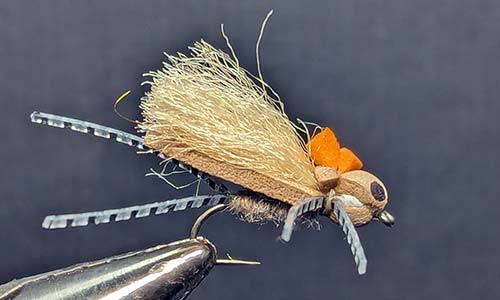 The Big Bob came about in roughly 2017 when the fish were on larger hoppers than our original Bob Hopper. The Big Bob has an extra set of legs (tails, really) and most colors have flashy dubbed bodies and pale wings for visibility. Think of it as a good changeup pattern for Chubby Chernobyls in most cases, and a pattern that tends to work better in August and September than the Chubby, which is better in July. Available in #10–12 and all sorts of colors, though gold, dark tan over pale tan (pictured), peach, tan & pink, purple, and dark brown over hot pink tend to be the best colors.
The Big Bob came about in roughly 2017 when the fish were on larger hoppers than our original Bob Hopper. The Big Bob has an extra set of legs (tails, really) and most colors have flashy dubbed bodies and pale wings for visibility. Think of it as a good changeup pattern for Chubby Chernobyls in most cases, and a pattern that tends to work better in August and September than the Chubby, which is better in July. Available in #10–12 and all sorts of colors, though gold, dark tan over pale tan (pictured), peach, tan & pink, purple, and dark brown over hot pink tend to be the best colors.
Bob Hopper

The “Bob” is our best hopper pattern and has been since 2012. We stock it in approximately fifteen colors, with the precise number depending on which cool shades of foam we can find in a given year. Pink (pictured), peach, and tan have always been the top colors, but sometimes the oddballs are just the ticket. The “Bob” is available only in #14 and has a thread underbody and lacks a tail, making it a lot less bulky than the Big Bob.
Brindle Cripple

The Brindle Cripple is our variation on Chuck Stranahan’s original Brindle Chute. Our version is tied in our preferred cripple (versus parachute) style and uses a synthetic wing post for better flotation and visibility. Critical in fall, because it can match Mahoganies, Tan Drakes, and even small grasshoppers. #12–16.
Clacka Caddis
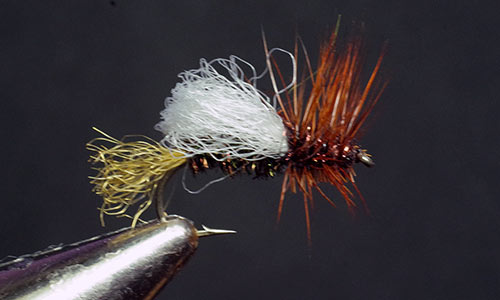
Walter combined elements from longtime favorite the classic Coachman Trude and Craig Mathews’ Iris Caddis to develop this buoyant and highly-visible yet low-floating caddis/attractor pattern. It one color or another it has been our most effective caddis pattern since 2009. It is particularly important on rough waters that see relatively heavy pressure, like the Yellowstone. We stock it in the following colors: Coachman (peacock), pink, and gingersnap. #12–16.
Flying Ant
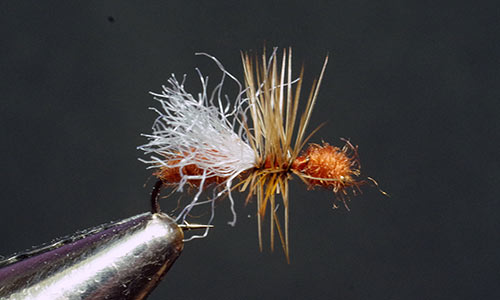
We tie our flying ants bushy and with split synthetic wings for better flotation and visibility. This is our preferred ant pattern for rougher waters, where it can be our best fly overall in August and September when the trout really want ants. Available in cinnamon and bicolor. The cinnamon color has some crossover appeal as a caddisfly. #14–16. Smaller ants in the same colors but with less hackle and without the wings are good choices on meadow streams in the Park.
GFA Hopper, Version 3.0
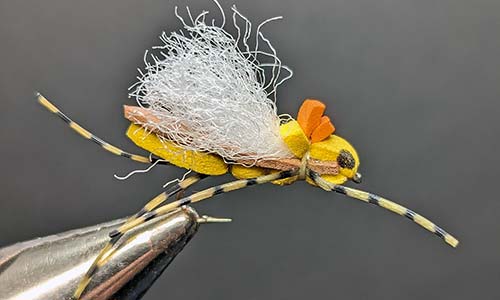
The GFA (General Foam Attractor) is probably our most famous fly, thanks to this video by Tim Flagler of Tightline Video, which is a slight variation on the original pattern in this video.
For awhile we tied the pattern with the foam under the hook shank and a Krystal Flash underwing. We called that one the “Improved GFA.”
Our latest variant is this one, which works when the trout want a longer-bodied hopper than our Bob Hopper or Big Bob, and/or we need a bit more flotation than provided by the original pattern. We tie it in numerous colors, but generally prefer it in brighter colors (like the brown/yellow here) with strong contrast between the upper and lower foams. #8–12.
Hazy Cripple
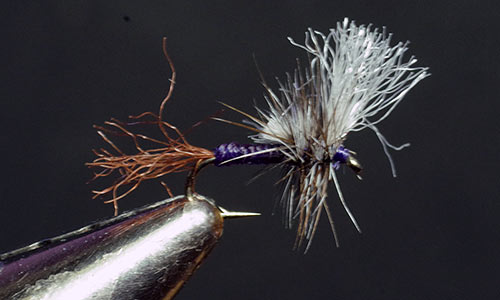
The purple version of this low-floating yet buoyant and visible attractor mayfly cripple is the single most important dry fly in our arsenal. There is not a month on the calendar when we don’t catch a fish on it, including December which otherwise is awfully grim. It’s most important on our waters from late August through the middle of October, when it works better than “realistic” flies when the fall gray Baetis are hatching.
Try this pattern in the right size, and we think it’s pretty likely it will be just the ticket in your home waters, too. We’ve had anglers from all over the world rave about its effectiveness, and when I worked in a fly shop we had guides come in and buy out the entire stock, then start telling people they invented it. No joke! The copper version is best on bright days in summer and fall. Both are available in #12 to #20 purple, #12 to #18 copper, and a couple experimental colors
Holo Cripple
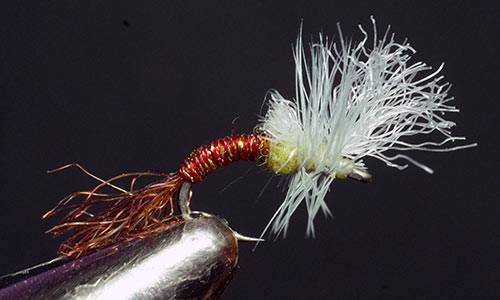
The Holo Cripple is the disco version of the Hazy Cripple. While generally not quite as effective as the original, it sometimes works better on rough water or as a changeup from the original. We often have the client in front of the boat fish a purple Holo Cripple and the client in back fishing a Hazy Cripple, so the trout see slightly different flies that nonetheless push the same buttons. Available in purple, olive, and the PMD version seen here, #14–18.
Pennant Dun
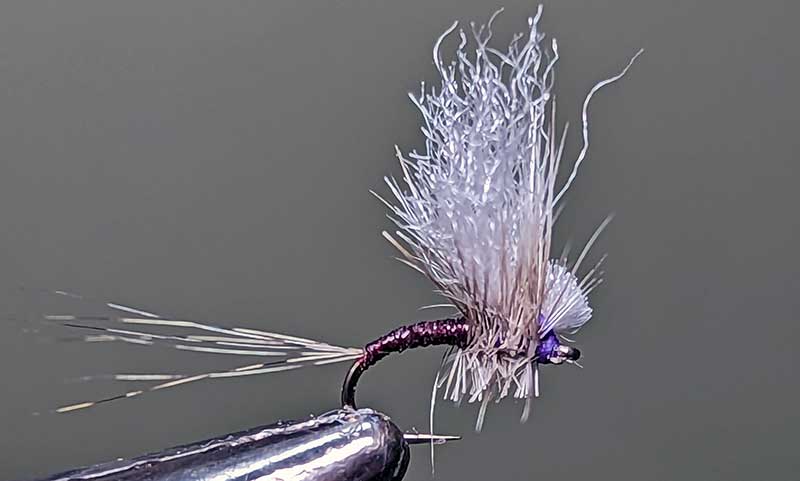
The Pennant Dun is our latest “purple concoction.” We designed this pattern to be slim and trim and to suggest both duns and spinners (thanks to the wide footprint from the dun-grizzly hackle), while having a huge wing to provide both visibility and buoyancy on rougher water. This pattern seems to work best on August and September mornings when there’s a bug or two on the water, but not a heavy hatch. Available in #16–18 in the wine color shown here, though we’ve had good reports on lots of other colors.
Phase Loopwing Emerger

The Phase Loopwing (usually tied in purple) offers a bit more flotation and a bit higher visibility than our other “purple bugs.” We tend to use it on the grayest, nastiest days, since it isn’t quite as popular with the trout when the sun is bright. This one is popular on the Missouri River near Craig. #14–18 and generally only available in purple, though we can custom-tie it in other colors.
Synth Double Wing
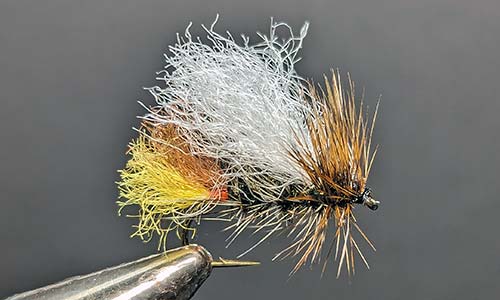
The Synth Double Wing is the big brother to the Clacka Caddis. This pattern is based on Gary Lafontaine’s original Double Wing, but it’s more durable and floats better than the older pattern thanks to its heavy synthetic wings. We tend to fish this one on the Yellowstone, Boulder, and Stillwater early in the season, when it probably looks like a Golden Stonefly or the large Chocolate Caddis we see at that time, but it’s also a good mountain creek fly throughout the season. #6–12, with #10 usually best. We can tie this puppy in other colors, if you like. These do take more time to tie than most of our flies, and use materials, so pricing is $18.00 per half-dozen.
Custom Nymphs
Euroflash

The Euroflash is our entry in the “sparse, skinny, fast-sinking” nymph category best-exemplified by the Perdigon. We tie these in red, purple, olive, and black, all in #16 and #18.
Fuzz Bastard
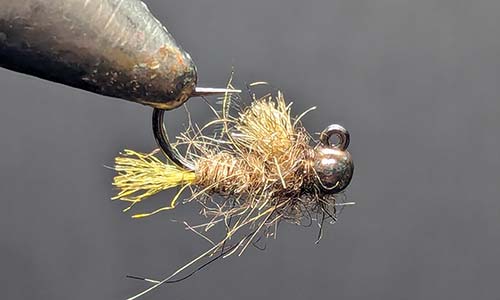
The Fuzz Bastard started off life in 2008 or so as a fuzzy cross between the Serendipity and the Prince nymph and carried the name “Hula Princess.” After a series of transformations, it’s now a jig-style caddis pupa pattern whose unusual name comes from a college friend’s dearly-departed cat (long story). Available in peacock and tan/brown as standard, though we sometimes use other colors as well. This attractor/pupa pattern is great in early summer as a changeup from standard Jig Princes and Sparkle Pupae.
Gussied Lightning Bug

The Gussied Lightning Bug is a version of the classic Lightning Bug with a bit more bling. It’s sort of the more-ostentatious version of the Euroflash, and we tend to fish it in similar colors (also gold and brown, in which it serves as a Yellow Sally nymph). Red with a black rib is a good substitute for the classic red Copper John. #12–18.
Custom Wet Flies & Soft Hackles
Don Emerger
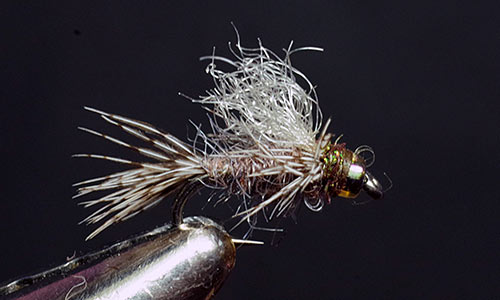
This fly has gone through enough permutations from the original pattern an Emigrant-based guide showed us that we figure we can claim it as our own. We named it after Don, though. We like this pattern both in spring and summer, but it’s particularly good around the Mother’s Day Caddis hatch on the Yellowstone and in June on the Madison. #14–16.
Glasshead Soft Hackle Pheasant Tail
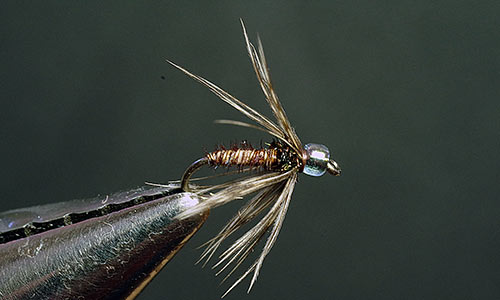
This is the first fly Walter developed after moving to Montana, in early June 2001. It instantly became and remains our single most effective fly on the Firehole River, and works well elsewhere also. On the Firehole, either swing it in conjunction with another soft hackle or fish it beneath a caddis dry. You can even deep-nymph with it if nothing else is working. On most other waters, we fish the pattern on a dead drift. #14-16.
White Miller Soft Hackle

No commercially-available pattern matches any stage of the White Miller (Nectopsyche caddis, the predominant insect on the Firehole. We tie multiple adult and egglaying/cripple versions (including a couple not pictured on this page) and two pupae. The most important pupa is this one. Fish it either on the swing with another soft hackle (the Glasshead PT perhaps) or on the dropper underneath a White Miller dry when the hatch is extra-heavy. #14.
Custom Streamers
Love Bunny

This nasty concoction of rabbit fur, rubberlegs, and hackle is our entry in the “Galloup-Style” sweepstakes. It’s available in olive, black, white, and tan, and should not be cast by the faint-hearted. The hooks are #2 and #4 and overall length is 4+ inches. $18.00 per 3.
Scleech
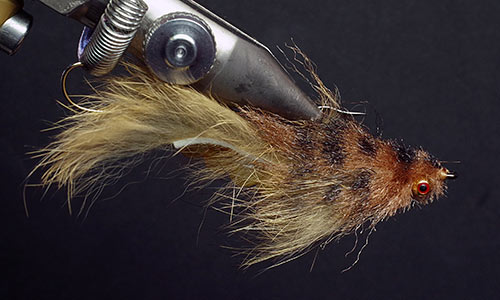
We don’t fish articulated streamers much, mostly because flies with double hooks aren’t legal in Yellowstone Park. This fly is the main exception. It’s Walter’s primary “big fish” fly on the Yellowstone River. He ties it small enough that the medium-sized fish will eat it too, and with a stinger hook so that the annoying little tail-nippers will also get stuck. Now available for wholesale purchase by your local shop from CATCH Fly Fishing. Pro tip: these are also great smallmouth streamers. Available in olive, black, gold (pictured), and white. When we custom-tie these, they run $18.00 for three.
KISS Sculpin
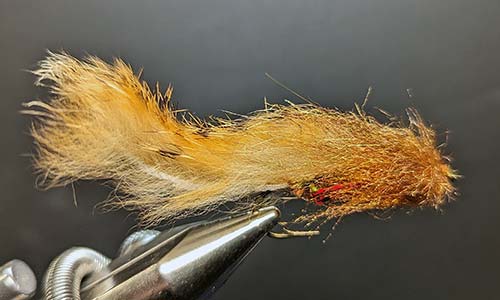
Sometimes simple is better. This unweighted and dirty-simple sculpin pattern is designed to wiggle and dance above the bottom. Fish it with a sliding bead ahead of it just like a plastic worm on a bass rod. Available in olive, black, white, rusty brown (pictured), and tan, all #2. $12.00 for three.